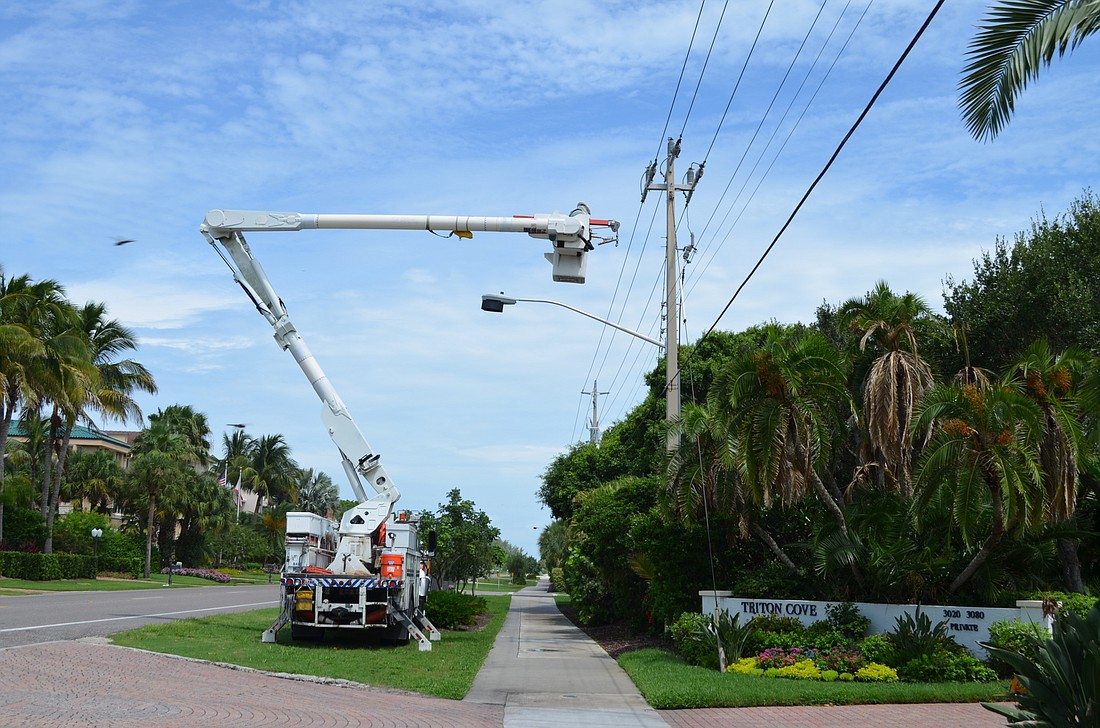- April 9, 2025
-
-
Loading

Loading

On Nov. 3, voters will head to the polls to determine the fate of Gulf of Mexico Drive power poles. Here’s everything you need to know about the referendum.
What are we voting on?
The referendum will determine whether the town can obtain bonds of no more than $25.25 million to bury overhead utilities along Gulf of Mexico Drive. The project also includes replacing/enhancing street lighting along the road and installing a fiber optic network.
Why are we voting on the issue?
Debate about burying the Key’s utilities have flickered on and off for at least two decades.
But the impetus for the referendum came in May 2014, when town staff proposed burying utilities in response to Florida Power & Light Co.’s plans to replace GMD power poles with larger, more hurricane-resistant poles.
The Longboat Key Town Commission initially rejected the idea but opted to reconsider after residents protested.
A charter amendment that 77% of Longboat Key voters approved in 1998 requires that the town obtain voter approval via a public referendum to obtain bonds of more than $800,000.
Why is the referendum limited to GMD?
The commission considered the possibility of an islandwide project but opted to separate the GMD project from a potential neighborhood/side street project.
The split was due in part to concerns about fairness: With a majority of the Key’s utilities already underground, commissioners and residents worried the estimated $42.2 million price tag of an islandwide project would cause voters, many of whom had already paid for their undergrounded utilities, to reject it.
Supporters say burying GMD utilities would benefit the aesthetics and safety of the entire island — even those residents whose properties are undergrounded — because the street is its main thoroughfare.
Undergrounding benefits
• Cheaper storm restoration and tree-trimming costs;
• Increased reliability and less power system damage during severe weather;
• Fewer power interruptions and outages;
• Improved aesthetics for property values;
• Safer — fewer car accidents and fires that can spark from overhead wires
Undergrounding drawbacks
• Costs involved with burying utilities are four to five times higher and that coast falls on the property owners
• Repairing outages can be five to 10 times more costly than overhead lines, however, once utilities are underground, Florida Power & Light (FPL) is responsible for maintenance and repairs.
• Repairing outages can take longer to locate issues underground.
• After severe weather events, water must recede before repairs underground can be made.
• Salt water flooding can shorten the life and increase maintenance to an underground system.
If voters say “yes:”
Collection of assessments and survey and design work will begin in 2016; construction will start in 2017 and take three years to complete.
If voters approve the Gulf of Mexico Drive referendum, the town will most likely draft a second referendum that addresses undergrounding in neighborhoods that currently have above-ground utilities. Town staff is not currently discussing the second referendum unless the GMD referendum passes, per instruction the commission gave town staff in September. The commission previously discussed a neighborhoods project estimated at $18.8 million that would be voted on and funded only by residents of above-ground communities. But commissioners want to find a fairer, more equitable way to fund that project.
If voters say “no:”
If the referendum doesn’t pass Nov. 3, FPL will resume efforts to install larger poles along Gulf of Mexico Drive.
The town will not hold a referendum to bury utilities for neighborhoods and side streets, but the commission could discuss another referendum option.
Communities with above-ground utilities could still opt to pay to bury their equipment, as Country Club Shores residents have vowed to do.
This article was amended Oct. 23 to reflect the following clarification: If Longboat Key residents opt to bury Gulf of Mexico Drive utilities, Florida Power & Light Co. will be responsible for ongoing maintenance and repair costs.